How to Reheat Tri Tip
To reheat tri-tip while maintaining its tenderness, you'll find several effective methods at your disposal. The oven method offers consistent results – wrap your meat tightly in foil and heat at 325°F until it reaches 165°F internally. For quicker results, use your microwave with a damp paper towel cover, heating in 15-second intervals. The air fryer (375°F for 3 minutes) and stovetop methods work well too, while sous vide provides precise temperature control. Always use a meat thermometer to guarantee food safety, and store leftovers properly in the refrigerator below 40°F. Each reheating technique offers unique benefits that'll help you perfect your approach to serving leftover tri-tip.
This post may contain affiliate links. If you make a purchase through these links, I may earn a commission at no additional cost to you. Additionally, portions of this post may be generated using artificial intelligence (AI) technology. While we strive for accuracy, please be aware that AI-generated content may not always be perfect and should be fact-checked when necessary.
The Spatula Scoops
- Preheat oven to 325°F and wrap tri-tip tightly in foil to maintain moisture while reheating until internal temperature reaches 165°F.
- For microwave reheating, cover with damp paper towel and heat in 10-15 second intervals, flipping halfway through.
- Use an air fryer at 375°F for 3 minutes with tri-tip wrapped in foil for quick, even heating.
- Add beef broth to slow cooker and heat tri-tip on low setting to maintain moisture and tenderness.
- Always use a meat thermometer to ensure tri-tip reaches a safe internal temperature of 165°F during reheating.
Best Reheating Methods Overview

When it comes to reheating tri tip, you'll find several effective methods to bring back its original flavor and tenderness. Each approach offers unique benefits, and you'll want to choose the one that best fits your time constraints and desired results. Worth mentioning that using a reliable meat thermometer to check the internal temperature is vital for guaranteeing food safety, especially if you're also handling any poultry like chicken in your kitchen. Following USDA guidelines, the safe internal temperature for meat should be confirmed to prevent risks of foodborne illness cooking guidelines for safety.
The oven method provides consistent heating by wrapping your beef in foil and cooking at 300°F for 10-15 minutes. If you're short on time, the microwave offers quick results at 50% power for 2-3 minutes, though you'll need to rearrange the pieces periodically. For those seeking a more hands-on approach, the stovetop method involves reheating your tri tip in a skillet with oil, while the air fryer delivers crispy results in just 5-7 minutes at 370°F.
For longer, hands-off reheating, you can use either a slow cooker or Instant Pot with added liquid. Regardless of your chosen method, you'll always want to slice the beef against the grain before reheating and use a reliable meat thermometer to guarantee proper temperature. This attention to detail helps maintain the tri tip's texture and prevents overcooking, which can lead to tough, dry meat.
Microwave Method and Tips
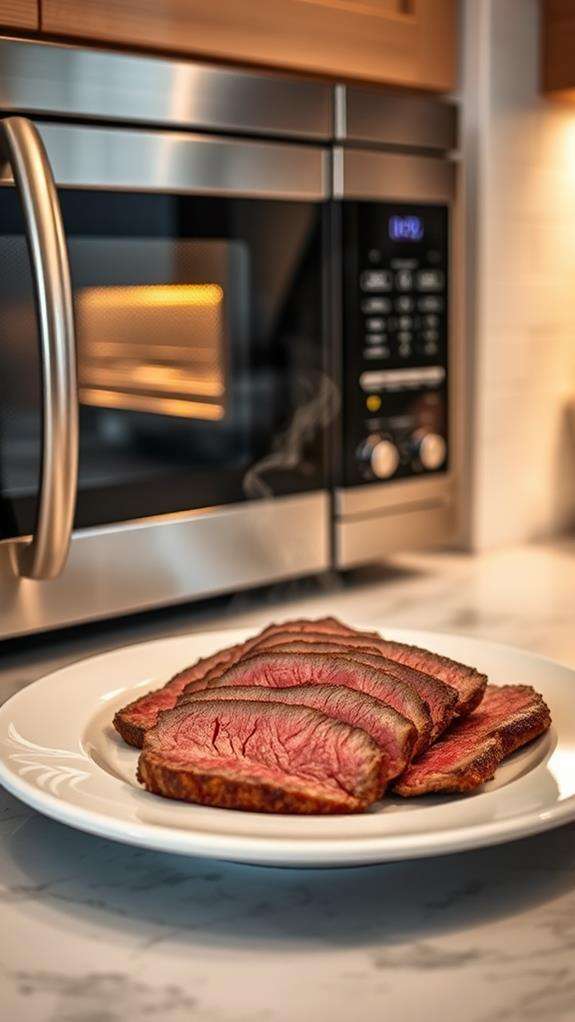
When reheating your tri-tip in the microwave, you'll need to prioritize both safety and moisture retention by using medium power settings and checking the temperature frequently with an instant-read thermometer like the ThermoPro TP-03B for accurate results. To keep your meat from drying out, cover it with a damp paper towel and place it in a microwave-safe dish, making sure to reheat in short 10-15 second intervals. You can preserve the tri-tip's quality by flipping larger pieces halfway through and monitoring the internal temperature until it reaches 130°F (54°C), being careful not to exceed this temperature which could lead to tough, overcooked meat.
Quick Heat Safety Steps
To safely reheat tri-tip in your microwave, start by placing the meat in a microwave-safe dish and covering it with a damp paper towel. This simple step helps retain moisture during the reheating process, preventing your tri-tip from becoming dry and tough.
Set your microwave to medium power and heat the meat in short 10-15 second intervals. You'll want to check the internal temperature between bursts using an instant-read thermometer until it reaches approximately 130°F (54°C). This careful approach guarantees you won't overcook the meat while achieving a safe serving temperature.
Keep a close eye on your tri-tip during reheating, as microwaving for too long can quickly turn your tender meat into a tough, unappetizing dish. Once you've reached the target temperature, remove the tri-tip from the microwave immediately. Let it rest for about a minute, allowing the internal juices to redistribute throughout the meat. This brief resting period is vital for maintaining the tri-tip's tenderness and confirming each bite remains as flavorful as possible when served.
Moisture Preservation Techniques
Preserving moisture while microwaving tri-tip requires three essential techniques for ideal results. You'll want to start by covering your leftover tri-tip with a damp paper towel, which acts as a moisture barrier and prevents the meat from drying out during reheating. Place the meat in a microwave-safe dish to guarantee safe and even heating throughout the process.
To maintain the tri-tip's tenderness, you'll need to use the right power settings and timing. Set your microwave to medium power and heat the meat in short 10-15 second intervals, checking the temperature between bursts. This prevent overcooking approach helps distribute heat evenly while maintaining the meat's natural juices. Using short bursts also gives you better control over the final temperature, which should reach approximately 130°F (54°C).
Once you've reached the desired temperature, let your tri-tip rest for about a minute. This resting period is vital as it allows the meat's internal juices to redistribute evenly throughout the cut. The result is a properly reheated piece of tri-tip that retains its moisture and flavor, making it almost as enjoyable as when it was first cooked.
Air Fryer Success Steps
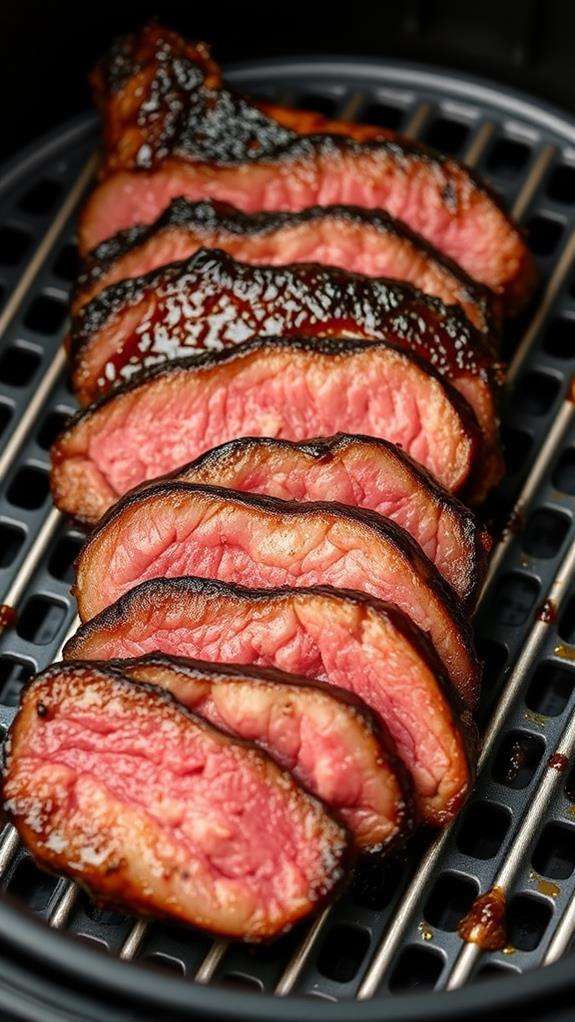
An air fryer can effectively breathe new life into leftover tri-tip when you follow these key steps. First, you'll want to preheat your air fryer to 375°F (190°C), which guarantees you're starting with the ideal temperature for reheating your meat evenly. Utilizing a high-quality stainless steel basket can also enhance your reheating process by promoting better air circulation, guaranteeing even heating across the meat 3pcs Stainless Steel Mesh Basket Set.
While your air fryer is warming up, wrap your leftover tri-tip tightly in aluminum foil. This vital step prevents moisture loss and helps maintain the meat's natural juices during the reheating process. Once wrapped, place your tri-tip in the air fryer basket and set the timer for 3 minutes.
After the initial cooking time, you'll need to check your meat's temperature. You're looking for an internal temperature of 130°F (54°C), which you can verify using a meat thermometer or the fingertip test. If it hasn't reached the desired temperature, continue cooking for up to 2 more minutes, checking frequently to avoid overcooking.
When your tri-tip reaches the right temperature, remove it carefully from the air fryer. Let it rest for about a minute before unwrapping to allow the juices to redistribute throughout the meat.
Perfect Oven Reheating Technique
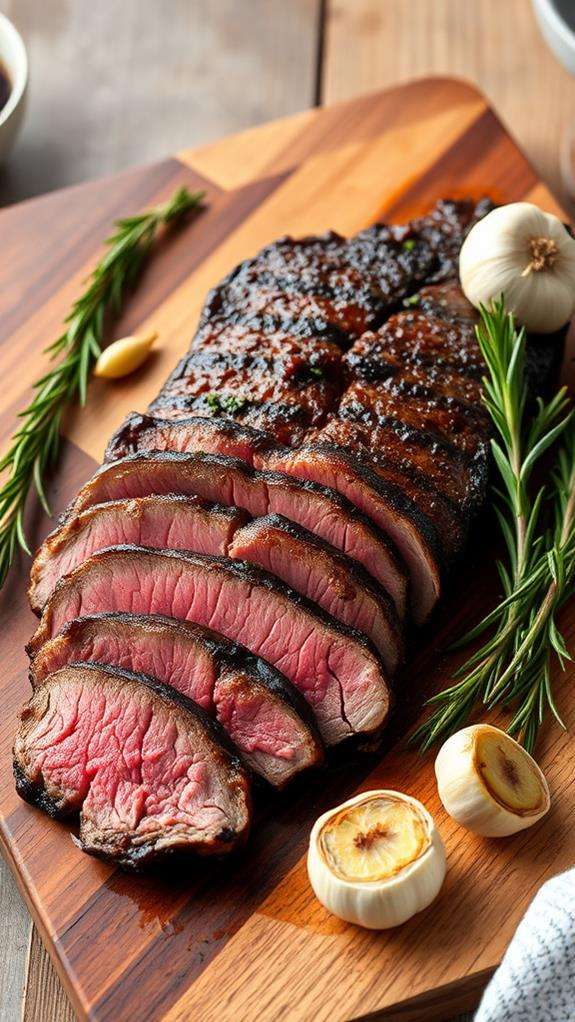
The oven consistently delivers excellent results when reheating tri-tip, provided you follow the proper temperature and timing guidelines. Start by bringing your meat to room temperature, then preheat your oven to 325°F. Create a tight foil packet around your tri-tip to lock in moisture and prevent drying.
| Temperature Target | Internal Temp (°F) | Internal Temp (°C) | Cooking Time |
|---|---|---|---|
| Medium-Rare | 130°F | 54°C | 5-7 mins |
| Medium | 140°F | 60°C | 7-8 mins |
| Medium-Well | 150°F | 65°C | 8-10 mins |
| Well-Done | 160°F | 71°C | 10-12 mins |
Place your foil-wrapped tri-tip in an oven-safe dish and monitor the internal temperature carefully to avoid overcooking. If you're using a convection oven, reduce your heating time by 25% and adjust the temperature accordingly. Once you've reached your desired doneness, let the meat rest for 1-2 minutes before unwrapping and serving. This resting period allows the juices to redistribute throughout the meat, ensuring each slice remains tender and flavorful.
Stovetop Skillet Instructions
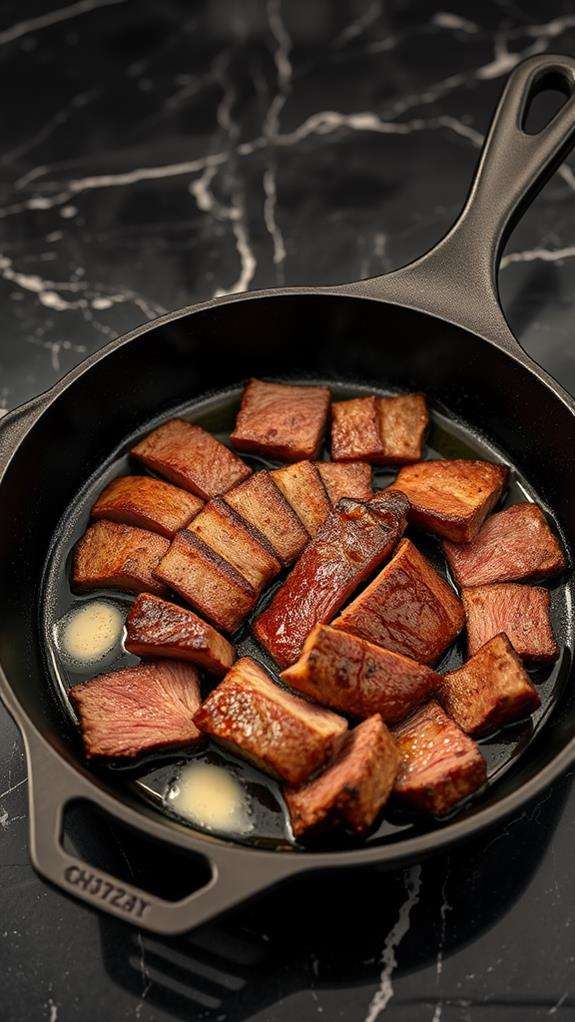
Reheating tri-tip on the stovetop gives you quick results with excellent control over the process. Place your skillet over medium heat and add a small amount of oil or butter to prevent the meat from sticking. You'll want to guarantee the pan is properly heated before adding your tri-tip to achieve the best results.
For the perfect stovetop reheat, follow these essential steps:
- Position your tri-tip in the hot skillet, listening for that gentle sizzle that indicates proper temperature
- Watch as the meat begins to warm, developing a slight crust on the exterior
- Use your meat thermometer to monitor the internal temperature as it climbs toward the target range
If you're working with whole tri-tip pieces, cook them for 2-3 minutes per side until they reach an internal temperature of 130°F to 135°F for medium-rare. For sliced portions, reduce your cooking time to just 1-2 minutes per side. Remember to let your reheated tri-tip rest for 1-2 minutes before serving to allow the juices to redistribute throughout the meat, guaranteeing each bite is as juicy as possible.
Sous Vide Reheating Guide
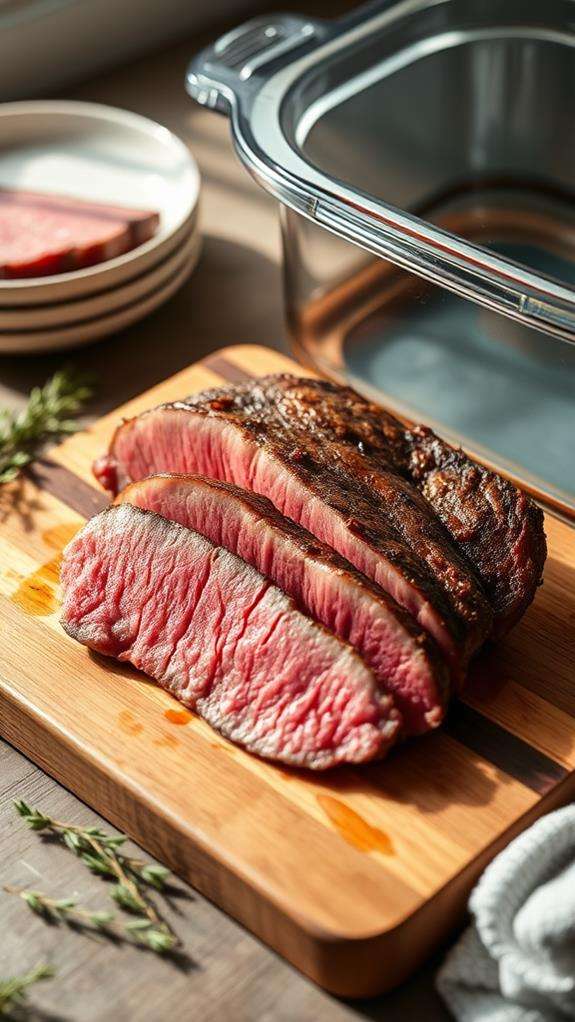
While stovetop methods offer speed and simplicity, sous vide reheating provides unparalleled precision and consistency for leftover tri-tip. This method guarantees your meat retains its original moisture and flavor, making it an excellent choice for those who don't want to compromise on quality.
To begin, you'll need to seal your leftover tri-tip in a sous vide-safe bag, either using water displacement or a vacuum sealer. Once sealed, set up your water bath by filling your sous vide device or slow cooker with water and setting the temperature between 120°F and 130°F for medium-rare results. Submerge your sealed leftovers completely in the heated water bath.
Allow your tri-tip to reheat slowly for 30 minutes to an hour, depending on its thickness. You'll want to verify the internal temperature reaches at least 130°F using a reliable meat thermometer. Once heated through, remove the tri-tip from its bag and pat it dry thoroughly with paper towels. For the finishing touch, quickly sear the exterior on a hot skillet or grill to restore that delicious crust, and you'll have perfectly reheated tri-tip that tastes nearly as good as when it was first cooked.
Using Your Slow Cooker
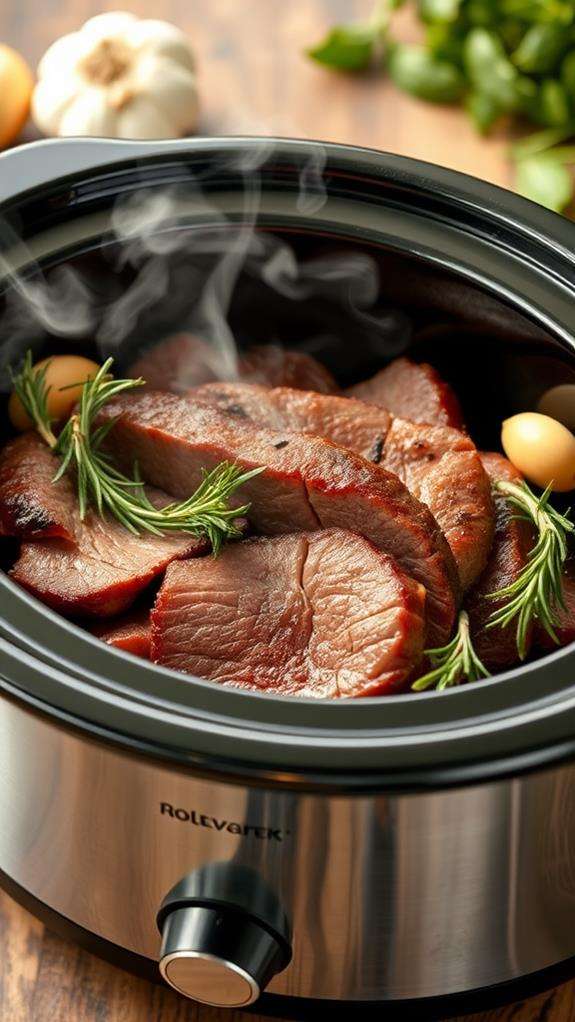
For busy home cooks who need a hands-off approach, slow cookers offer a reliable method to reheat tri-tip while preserving its tenderness. Using your crock pot method, you'll need to add 1/4 cup of liquid, preferably beef broth, to guarantee your meat stays moist throughout the reheating process.
To achieve the best way to reheat your tri-tip, follow these essential steps:
- Place your leftover tri-tip in the slow cooker, verifying it's surrounded by the liquid and any additional aromatics
- Set your slow cooker to low temperature and allow it to heat for 1-2 hours, depending on the quantity
- Monitor the internal temperature with a meat thermometer until it reaches 165°F (74°C)
For enhanced flavor, you can add vegetables like onions, carrots, and celery alongside your leftovers within 2 hours of your planned mealtime. This method works particularly well when reheating larger portions of tri-tip, as the slow, even heating helps maintain the meat's original texture and juiciness. Remember to keep the temperature low to prevent overcooking, which could result in tough, dry meat.
Food Safety While Reheating
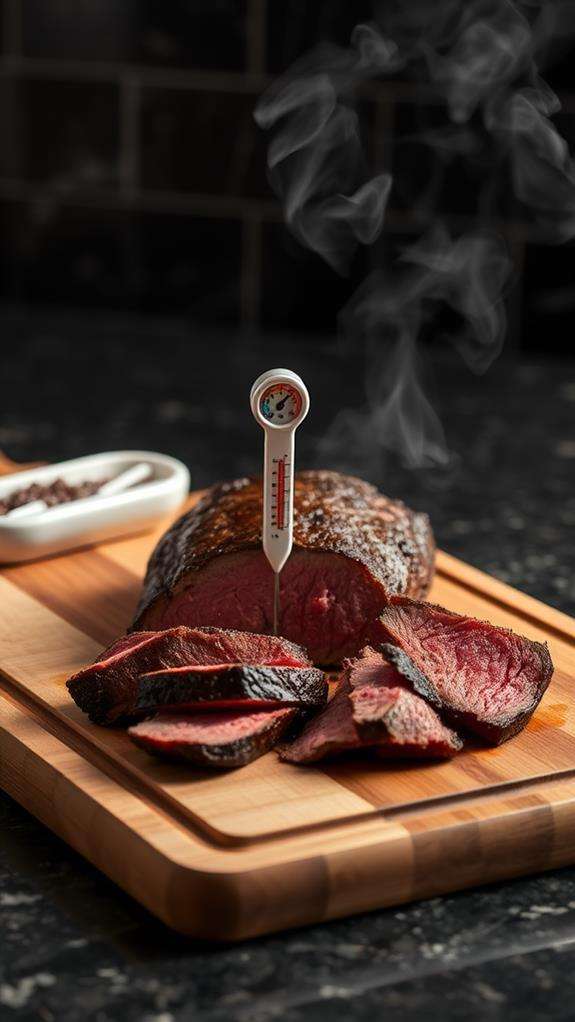
You'll need to closely monitor temperature when reheating tri-tip, ensuring it reaches 165°F (74°C) throughout to eliminate harmful bacteria like Salmonella and Staphylococcus aureus. When removing tri-tip from your refrigerator, you've got a two-hour window to reheat it properly, and it's vital to store leftovers in shallow containers at 40°F (4°C) or below. To maintain food safety, you should only reheat your tri-tip once, as multiple reheating cycles can create dangerous conditions for bacterial growth.
Temperature Control Guidelines
Maintaining proper temperature control is essential when reheating tri-tip to guarantee food safety. You'll need to guarantee the meat reaches an internal temperature of 165°F (74°C) to eliminate any harmful bacteria that could cause foodborne illness. Using a food thermometer is your most reliable tool for accurate temperature measurement during the reheating process.
To achieve ideal temperature control while reheating your tri-tip, follow these key steps:
- Insert the food thermometer into the thickest part of the meat, avoiding fat or bone, to get an accurate reading
- Monitor the temperature regularly throughout the reheating process, guaranteeing it stays above 145°F (63°C)
- Remove the tri-tip once it reaches 165°F (74°C), but don't exceed 180°F (82°C)
Remember that maintaining consistent temperature control isn't just about food safety – it's also imperative for preserving the meat's quality. If you heat your tri-tip beyond 180°F (82°C), you'll risk drying it out and making it tough. Don't rely on visual cues alone; your food thermometer is the most dependable way to guarantee both safety and quality.
Proper Storage Rules
Safe storage practices lay the foundation for successfully reheating your tri-tip without compromising food safety. When you've finished your meal, don't let your leftover tri-tip sit at room temperature for more than two hours. Instead, promptly transfer it to shallow, airtight containers and place them in your refrigerator, where the temperature should stay below 40°F (4°C).
Make sure you're labeling your containers with dates, as leftover tri-tip remains safe in the refrigerator for three to four days. If you won't be eating it within this timeframe, consider freezing it for extended storage. Before reheating your stored tri-tip, always inspect it carefully for any signs of spoilage. Check for unusual odors, slimy texture, or visible mold growth – if you notice any of these warning signs, it's best to discard the meat. When you're ready to reheat, remember that your tri-tip must reach an internal temperature of 165°F (74°C) to guarantee any potential bacteria are eliminated. This temperature requirement applies whether you're reheating from refrigerated or properly thawed frozen state. Following these storage guidelines will help maintain both the safety and quality of your reheated tri-tip.
Frequently Asked Questions
How Do You Reheat Tri-Tip Without Drying It Out?
To reheat tri-tip without drying it out, you'll want to slice it against the grain first. Heat your oven to 300°F, wrap the slices in foil with a splash of beef broth, and heat for 10-15 minutes. Alternatively, you can use your slow cooker on low for 1-2 hours with ¼ cup of liquid. Don't forget to check the internal temperature with a meat thermometer until it reaches 165°F for safe consumption.
How Do You Reheat Meat Without Drying It Out?
Did you know that reheating meat can rob it of up to 40% of its moisture if done incorrectly? To keep your meat juicy, you'll want to wrap it tightly in foil, add a tablespoon of liquid (broth or water), and heat it slowly at 250°F. You can also use your microwave with a damp paper towel cover, heating in 30-second intervals. Don't forget to let it rest for 3-5 minutes before serving.
What Temperature Do You Reheat Meat at in the Oven?
To safely reheat meat in the oven, you'll want to set your temperature between 300°F and 350°F (150°C-175°C). You should heat the meat until it reaches an internal temperature of 165°F (74°C), which you can verify using a meat thermometer. For best results, cover your dish with foil or use a Dutch oven to maintain moisture. Plan for about 10-15 minutes of heating time per pound of meat.
How to Keep Tri-Tip Warm Without Overcooking?
You can keep your tri-tip warm without overcooking by using several reliable methods. Place it in a chafing pan with a heat source, maintaining 130-140°F. Alternatively, wrap it in foil and set it in a low-temperature oven at 150-200°F. You'll want to use a thermometer to monitor the meat's internal temperature, ensuring it doesn't exceed 140°F. For precise control, consider using a sous vide machine set to 130-140°F.





